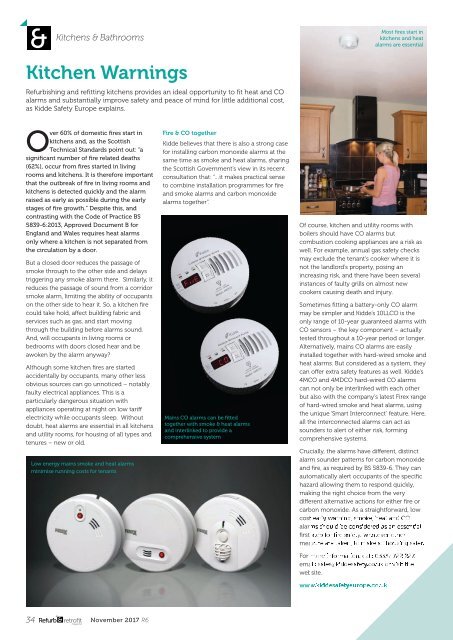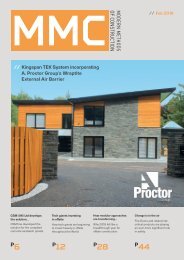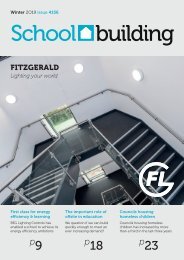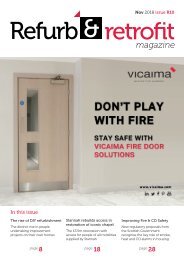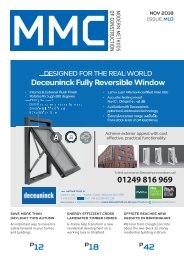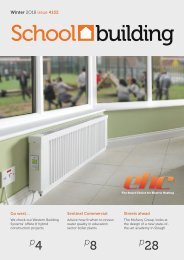You also want an ePaper? Increase the reach of your titles
YUMPU automatically turns print PDFs into web optimized ePapers that Google loves.
Kitchens & Bathrooms<br />
Most fires start in<br />
kitchens and heat<br />
alarms are essential<br />
Kitchen Warnings<br />
Refurbishing and refitting kitchens provides an ideal opportunity to fit heat and CO<br />
alarms and substantially improve safety and peace of mind for little additional cost,<br />
as Kidde Safety Europe explains.<br />
Over 60% of domestic fires start in<br />
kitchens and, as the Scottish<br />
Technical Standards point out: “a<br />
significant number of fire related deaths<br />
(62%), o<strong>cc</strong>ur from fires started in living<br />
rooms and kitchens. It is therefore important<br />
that the outbreak of fire in living rooms and<br />
kitchens is detected quickly and the alarm<br />
raised as early as possible during the early<br />
stages of fire growth.” Despite this, and<br />
contrasting with the Code of Practice BS<br />
5839-6:2013, Approved Document B for<br />
England and Wales requires heat alarms<br />
only where a kitchen is not separated from<br />
the circulation by a door.<br />
But a closed door reduces the passage of<br />
smoke through to the other side and delays<br />
triggering any smoke alarm there. Similarly, it<br />
reduces the passage of sound from a corridor<br />
smoke alarm, limiting the ability of o<strong>cc</strong>upants<br />
on the other side to hear it. So, a kitchen fire<br />
could take hold, affect building fabric and<br />
services such as gas, and start moving<br />
through the building before alarms sound.<br />
And, will o<strong>cc</strong>upants in living rooms or<br />
bedrooms with doors closed hear and be<br />
awoken by the alarm anyway?<br />
Although some kitchen fires are started<br />
a<strong>cc</strong>identally by o<strong>cc</strong>upants, many other less<br />
obvious sources can go unnoticed – notably<br />
faulty electrical appliances. This is a<br />
particularly dangerous situation with<br />
appliances operating at night on low tariff<br />
electricity while o<strong>cc</strong>upants sleep. Without<br />
doubt, heat alarms are essential in all kitchens<br />
and utility rooms, for housing of all types and<br />
tenures – new or old.<br />
Low energy mains smoke and heat alarms<br />
minimise running costs for tenants<br />
Fire & CO together<br />
Kidde believes that there is also a strong case<br />
for installing carbon monoxide alarms at the<br />
same time as smoke and heat alarms, sharing<br />
the Scottish Government’s view in its recent<br />
consultation that: “…it makes practical sense<br />
to combine installation programmes for fire<br />
and smoke alarms and carbon monoxide<br />
alarms together”.<br />
Mains CO alarms can be fitted<br />
together with smoke & heat alarms<br />
and interlinked to provide a<br />
comprehensive system<br />
Of course, kitchen and utility rooms with<br />
boilers should have CO alarms but<br />
combustion cooking appliances are a risk as<br />
well. For ex<strong>amp</strong>le, annual gas safety checks<br />
may exclude the tenant’s cooker where it is<br />
not the landlord’s property, posing an<br />
increasing risk, and there have been several<br />
instances of faulty grills on almost new<br />
cookers causing death and injury.<br />
Sometimes fitting a battery-only CO alarm<br />
may be simpler and Kidde’s 10LLCO is the<br />
only range of 10-year guaranteed alarms with<br />
CO sensors – the key component – actually<br />
tested throughout a 10-year period or longer.<br />
Alternatively, mains CO alarms are easily<br />
installed together with hard-wired smoke and<br />
heat alarms. But considered as a system, they<br />
can offer extra safety features as well. Kidde’s<br />
4MCO and 4MDCO hard-wired CO alarms<br />
can not only be interlinked with each other<br />
but also with the company’s latest Firex range<br />
of hard-wired smoke and heat alarms, using<br />
the unique ‘Smart Interconnect’ feature. Here,<br />
all the interconnected alarms can act as<br />
sounders to alert of either risk, forming<br />
comprehensive systems.<br />
Crucially, the alarms have different, distinct<br />
alarm sounder patterns for carbon monoxide<br />
and fire, as required by BS 5839-6. They can<br />
automatically alert o<strong>cc</strong>upants of the specific<br />
hazard allowing them to respond quickly,<br />
making the right choice from the very<br />
different alternative actions for either fire or<br />
carbon monoxide. As a straightforward, low<br />
cost early warning, smoke, heat and CO<br />
alarms should be considered as an essential<br />
first step for fire safety, whatever other<br />
measure are taken, to make all housing safer.<br />
For more information, call: 03337 722 227,<br />
email: sales@kiddesafety.co.uk or visit the<br />
website.<br />
www.kiddesafetyeurope.co.uk<br />
34 Refurb retrofit<br />
magazine<br />
<strong>November</strong> 20<strong>17</strong> R6


